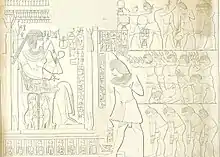| Khaemhat in hieroglyphs | |||||
|---|---|---|---|---|---|
| Era: New Kingdom (1550–1069 BC) | |||||

Khaemhat, also called Mahu, was an ancient Egyptian high official in charge under king Amenhotep III (about 1388 BC to 1351 BC/1350 BC).[1] Khaemhat was royal scribe and overseer of the double granary of Upper and Lower Egypt and was therefore responsible for the grain and food supply to the royal palace. Khaemhat is mainly known from his Theban tomb chapel (TT57)[2] that is decorated with reliefs and shows him twice in front of king Amenhotep III. Khaemhat is also mentioned on jar labels found at Malqata, the palace of the king. The inscriptions date to year 30 and year 39 of the king's reign, providing evidence that he was in charge in the later years of the king's 39-year-long reign.[3] Khaemhat was the son of an official called Iemhotep.
References
- ↑ Wolfgang Helck: Zur Verwaltung des Mittleren und Neuen Reichs, 1958, p. 499-500
- ↑ Gaston Maspero - Urbain Bouriant - Victor Loret - H. Dulac (editors): Victor Loret: La Tombe de Khâ-M-Hâ, in: Mémoires publiés par les membres de la mission archéologique française au Caire. Tome premier. Fasc. 1, Paris 1889, 113-132; online
- ↑ William C. Hayes: Inscriptions from the Palace of Amenhotep III, in: Journal of Near Eastern Studies, Vol. 10, No. 2. (Apr., 1951), p. 100, online: